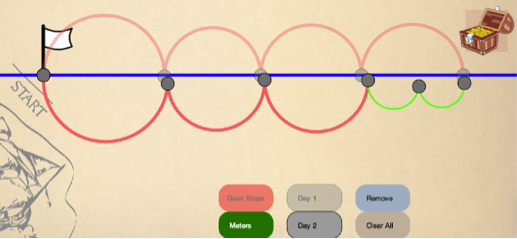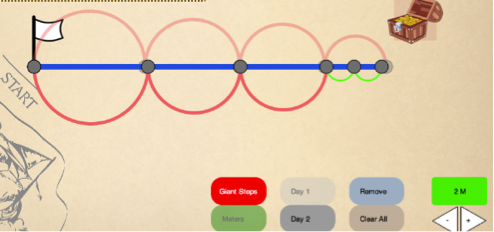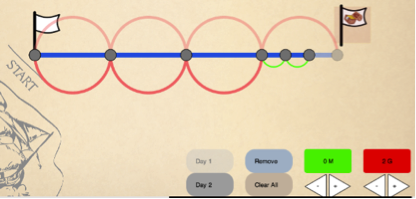Overview
Giant Steps for Algebra (GS4A) is the dissertation project of Kiera Chase.
GS4A is a design-based research project investigating the cognition, teaching, and learning of early algebra. The project is centered on a technology-based activity, in which students use computer-interface resources so as to model a narrative about a giant burying stolen treasure on a desert island. The idea is for students to ‘re-invent’ the basic principles of algebraic thinking, and in particular solving a system of two story-equations.
The project led to developing a design construct we call “reverse scaffolding.” This means that rather that a teacher offering support that then fades out, it is the student who initiates and builds new mathematical functions that then fade in. By ‘fade in’ we mean that the computer takes over enacting those functions, thus freeing up the student to work on higher-order issues. Importantly, reverse-scaffolding activities provide supports for the enactment of what students already know to do, not what they do not yet know to do, thus essentially reversing the classical scaffolding didactical paradigm.
Another new construct that emerged from the project is that of a SILO — situated intermediary learning objective — which attempts to capture a proto-conceptual type of practical knowledge that emerges for students as they organize information diagrammatically toward solving a problem. We believe that the SILOs are what people learn as they work on open-ended problems — it’s the stuff that mathematical meaning is made of, as students advance to formalizing and symbolizing this pragmatic knowledge.
The GS4A project work built on ideas coming from constructionism as well as the related idea of transparency. Our various publications explain the rationale, early work, results from the main study, and reflections on the design process.
In GS4A, users read texts about problematic situations they are to solve, and they are given a set of generic tools to model these situations.
| A Giant walked 3 steps and then another 2 meters. She buried the treasure. On the next day, she wanted to bury more treasure in exactly the same place, but she was not sure where that place was. She walked 4 steps and then, feeling she’d gone too far, she walked back one meter. Yes! She found the treasure! |

A sample GS4A narrative (on the left) and its model (on the right). On Day 1, above the line, and Day 2, below the line, the giant travels from the flag. Red loops represent giant steps, green loops represent meters.
The central goals of this research project are to answer the following questions:
- What are effective design heuristics for creating discovery learning activities? How might such activities avail of technological functionalities?
- In particular, is it possible to create a microworld based on constructionist principles, wherein students learn mathematics content through building artifacts? Can a learning design balance constructionist principles with specific curricular goals? What particular activity architecture would achieve this balance?
- To the extent that the activity is effective, how exactly does building artifacts lead to content learning?
In the course of modeling the situations, students discover a set of context-specific pragmatic principles that we call “situated intermediary learning objectives” (SILOs).
- Consistent measures. All variable units (giant steps) and all fixed units (meters) are respectively uniform in size both within and between expressions (days);
- Equivalent expressions. The two expressions (Day 1 and Day 2) are of identical magnitude—they share the “start” and the “end” points, so that they subtend precisely the same linear extent (even though the total distance traveled may differ between days, such as when a giant oversteps and then goes back);
- Shared frame of reference.The variable quantity (giant steps) can be described in terms of the unit quantity (meters).
As students progress through the activity, they realized the shortcomings of the available generic interface tools for generating and maintaining the SILOs. With each articulation of what the mathematical tool should do, the technological learning environment took on the enactment of that particular feature, thus relieving the students from enacting it themselves. This is what we mean by reverse scaffolding. The approach thus levels the development of transparency, and reverse-scaffolds student learning. Here are the interface levels, with each level giving students the new tools they know they need.
Level 1. In Level 1, Free Form, users create all parts of the model manually. Note that the giant steps (red arches) are not quite uniform size; neither are the meters (green arches).

Level 2. In Level 2, Fixed Meter, the meters are uniform in size while the giant steps remain variable. Users interact with a symbolic control (bottom-right corner) to generate meters.

Level 3. In Level 3, Stretchy, green arches (meters) are invariable, while red arches (giant steps) are variable via uniform scaling. A new control (bottom-right corner) now enables the user to generate a specified number of giant steps, not only meters.

In the empirical work, we set up an experimental and control group. The experimental group worked in the reverse-scaffolding pedagogical approach, whereas the control group worked according to classical scaffolding, where all the help students might need was all provided at the beginning of the activity.
You can interact with the reverse-scaffolding interface or with the regular-scaffolding interface.
Publications
Abrahamson, D., & Chase, K. (2020). Syntonicity and complexity: A design-based research reflection on the Piagetian roots of Constructionism. In N. Holbert, M. Berland, & Y. Kafai (Eds.), Designing constructionist futures: The art, theory, and practice of learning designs (pp. 311–322). MIT Press.
Chase, K., & Abrahamson, D. (2018). Searching for buried treasure: Uncovering discovery in discovery-based learning. In D. Abrahamson & M. Kapur (Eds.), Practicing discovery-based learning: Evaluating new horizons <Special issue>. Instructional Science, 46(1), 11-33.
ABSTRACT: Forty 4th and 9th grade students participated individually in tutorial interviews centered on a problem-solving activity designed for learning basic algebra mechanics through diagrammatic modeling of an engaging narrative about a buccaneering giant burying and unearthing her treasure on a desert island. Participants were randomly assigned to experimental (Discovery) and control (No-Discovery) conditions. Mixed Method analyses revealed greater learning gains for Discovery participants. Elaborating on a heuristic activity architecture for technology-based guided-discovery learning (Chase and Abrahamson 2015), we reveal a network of interrelated inferential constraints that learners iteratively calibrate as they each refine and reflect on their evolving models. We track the emergence of these constraints by analyzing annotated transcriptions of two case-study student sessions and argue for their constituting role in conceptual development.
Chase, K., & Abrahamson, D. (2015). Reverse-scaffolding algebra: Empirical evaluation of design architecture. In A. Bakker, J. Smit, & R. Wegerif (Eds.), Scaffolding and dialogic teaching in mathematics education <Special issue>. ZDM Mathematics Education, 47(7), 1195-1209.
ABSTRACT: Scaffolding is the asymmetrical social co-enactment of natural or cultural practice, wherein a more able agent implements or performs for a novice elements of a challenging activity. What the novice may not learn, however, is how the expert’s co-enactments support the activity. Granted, in many cultural practices novices need not understand underlying process. But where process is content, such as mathematics, scaffolding is liable to undermine tenets of reform-oriented pedagogy. We point to tensions between traditional conceptualizations of scaffolding and discovery-based pedagogical methodology for mathematics education. Focusing on co-enactment as a critical feature of scaffolding activities, we introduce “reverse scaffolding”, wherein experts enact for novices only what they know to do rather than what they do not know to do. We demonstrate our approach by discussing a novel technological learning activity, Giant Steps for Algebra, wherein students construct models of realistic narratives. We argue for the method’s potential via reporting on findings from mixed methods analyses of a quasi-experimental implementation with 40 students.
Abrahamson, D., & Chase, K. (2015). Interfacing practices: Domain theory emerges via collaborative reflection. Reflective Practice, 16(3), 372-389.
ABSTRACT: Can reflective practice help an interdisciplinary team collaborate? When a new team begins negotiating their working process toward achieving project deliverables, members implicitly bring diverse professional practices to the table. Once minimal common ground has been established, members specify what they each need from the other in order to implement their respective expertise. This process of imposing mutual constraints results in adjusted workflow protocols that may modify participants’ regular course of action yet are vital for facilitating the collaboration. Yet, we argue, this discursive process of negotiating collaboration protocols in interdisciplinary projects may result in more than just surface reconfiguration of local practices. The negotiation may yield an articulated reification of implicit know-how in the form of new theoretical constructs bearing potential impact beyond the local context of the project. We support the argument by presenting and analyzing archived records gathered from an interdisciplinary project, in which educational researchers and technology engineers collaborated in creating new instructional media for young mathematics students. In the course of struggling to formulate a mutually coherent workflow, the team ‘stepped back’ to formulate new goals that would address their coordination challenges. In turn, these goals implicated a new theoretical architecture that we present.
Chase, K., & Abrahamson, D. (2015). Reverse scaffolding: A constructivist design architecture for mathematics learning with educational technology. In B. Shapiro, C. Quintana, S. Gilutz, & M. Skov (Eds.), Proceedings of the 14th annual conference of ACM SIGCHI Interaction Design & Children (IDC 2015) (Vol. “Full papers”, pp. 189-198). Tufts University, Boston: ACM.
ABSTRACT: In the context of a design-based research effort to develop a technology-enabled constructivist algebra unit, a new activity architecture emerged that steps students through discovery levels. As they build a virtual model of a problem situation, students figure out technical principles for assuring the model’s fidelity to the situation. These construction heuristics, we find, are precisely the conceptual foundations of algebra, such as tinkering with the model to assure that the variable quantity is of consistent size throughout the model. We articulated these principles as situated intermediary learning objectives (SILOs). At each interaction level, the student discovers a SILO, and then the technology takes over by automatizing that SILO, thus freeing the student for further discovery. We call this architecture reverse scaffolding, because the cultural mediator thus relieves learners from performing what they know to do, not from what they do not know to do. In a quasi-experimental evaluation study (Grades 4 & 9; n=40), reverse-scaffolding students outperformed direct scaffolding students, for whom the technical features were preautomatized. We speculate on the architecture’s generalizability.
Abrahamson, D., Chase, K., Kumar, V., & Jain, R. (2014). Leveling transparency via situated, intermediary learning objectives. In J. L. Polman, E. A. Kyza, D. K. O’Neill, I. Tabak, W. R. Penuel, A. S. Jurow, K. O’Connor, T. Lee, & L. D’Amico (Eds.), Proceedings of “Learning and Becoming in Practice,” the 11th International Conference of the Learning Sciences (ICLS) 2014 (Vol. 1, pp. 23-30). Boulder, CO: International Society of the Learning Sciences.
ABSTRACT: When designers set out to create a mathematics learning activity, they have a fair sense of its objectives: students will understand a concept and master relevant procedural skills. In reform-oriented activities, students first engage in concrete situations, wherein they achieve situated, intermediary learning objectives (SILOs), and only then they rearticulate their solutions formally. We define SILOs as heuristics learners devise to accommodate contingencies in an evolving problem space, e.g., monitoring and repairing manipulable structures so that they model with fidelity a source situation. Students achieve SILOs through problem-solving with media, instructors orient toward SILOs via discursive solicitation, and designers articulate SILOs via analyzing implementation data. We describe the emergence of three SILOs in developing the activity Giant Steps for Algebra. Whereas the notion of SILOs emerged spontaneously as a framework to organize a system of practice, i.e. our collaborative design, it aligns with phenomenological theory of knowledge as instrumented action.
Chase, K., & Abrahamson, D. (2013). Rethinking transparency: constructing meaning in a physical and digital design for algebra. In J. P. Hourcade, E. A. Miller, & A. Egeland (Eds.), Proceedings of the 12th Annual Interaction Design and Children Conference (IDC 2013) (Vol. “Short Papers”, pp. 475-478). New York: The New School & Sesame Workshop.
ABSTRACT: In the course of developing an experimental algebra unit, the researchers noted variability in their design’s instructional potential across a set of implementation media. In an effort to explain this variability, we revisited the classical theoretical construct of transparency. Transparency is the perceptual and conceptual accessibility of the mechanism, logic, and application of a tool. Corroborating earlier literature, it appears that participants saw only what they had built—transparency is a subjective achievement of a learner rather than an inherent feature of a device. Our first design prompted students with an algebraic proposition, for example “3x+2=4x-1”. The two equivalent expressions were to be interpreted by students as alternative quantifications of a single linear spatial interval; namely, the path that a giant took on two separate occasions to bury and recover treasure. Problem solving required manually adjusting the modeling media to coordinate two types of equivalence: (a) the total length represented by each expression; and (b) the length represented by the variable and known units. The researchers found that successful coordination was predicated on the subjective transparency of the models’ perceptual. Therefore, in redesigning the activity as a computer-based application we will have learners first construct tools and only then automatize them.